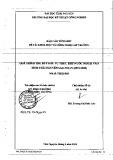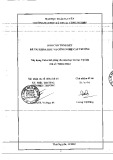
NANO EXPRESS Open Access
Spin effects in InAs self-assembled quantum dots
Ednilson C dos Santos
1
, Yara Galvão Gobato
1*
, Maria JSP Brasil
2
, David A Taylor
3
, Mohamed Henini
3
Abstract
We have studied the polarized resolved photoluminescence in an n-type resonant tunneling diode (RTD) of GaAs/
AlGaAs which incorporates a layer of InAs self-assembled quantum dots (QDs) in the center of a GaAs quantum
well (QW). We have observed that the QD circular polarization degree depends on applied voltage and light
intensity. Our results are explained in terms of the tunneling of minority carriers into the QW, carrier capture by
InAs QDs and bias-controlled density of holes in the QW.
Introduction
Resonant tunneling diodes (RTDs) are interesting
devices for spintronics because the spin character of the
carriers can be voltage selected [1-4]. Furthermore, spin
properties of semiconductor quantum dots (QDs) are
also of high interest because electron spins can be used
as a quantum bit [5] for quantum computing [6] and
quantum communication [7]. In this paper, we have stu-
died spin polarization of carriers in resonant tunneling
diodes with self-assembled InAs QD in the quantum
well region. The spin-dependent carrier transport along
the structure was investigated by measuring the left-
and right-circularly polarized photoluminescence (PL)
intensities from InAs QD and GaAs contact layers as a
function of the applied voltage, laser intensity and mag-
neticfieldsupto15T.WehaveobservedthattheQD
polarization degree depends on bias and light intensity.
Our experimental results are explained by the tunneling
of minority carriers into the quantum well (QW), carrier
capture into the InAs QDs, carrier accumulation in the
QW region, and partial thermalization of minority
carriers.
Our devices were grown by molecular beam epitaxy on
an+ (001) GaAs substrate. The double-barrier structure
consists of two 8.3-nm Al
0.4
Ga
0.6
As barriers and a 12-
nm GaAs QW. A layer of InAs dots was grown in the
center of the well by depositing 2.3 monolayers of InAs.
Undoped GaAs spacer layer of width 50 nm separate the
Al
0.4
Ga
0.6
As barriers from 2 × 10
17
cm
-3
n-doped GaAs
layers of width 50 nm. Finally, 3 × 10
18
cm
-3
n-doped
GaAs layers of width 0.3 nm were used to form contacts.
Our samples were processed into circular mesa
structures of 400 μm diameter. A ring-shaped electrical
contact was used on the top of the mesa for optical
access and PL and transport measurements under light
excitation. Magneto-transport and polarized resolved PL
measurements were performed at 2 K under magnetic
fields up to 15 T parallel to the tunnel current by using
an Oxford Magnet with optical window in the bottom.
The measurements were performed by using a Prince-
ton InGaAs array diode system coupled with a single
spectrometer. A linearly polarized line (514 nm) from
an Ar
+
laser was used for optical excitation. Therefore,
photogenerated carriers in the device do not present
any preferential spin polarization degree. The right (s
+
)
and left (s
-
) circularly polarized emissions were selected
with appropriate optics (quarter wave plate and
polarizer).
Results and discussion
Figure 1 shows the schematic potential profile and car-
rier dynamics in our device. Under applied bias voltage,
electrons are injected from the GaAs emitter layer into
the QW region. Resonant tunneling condition is
obtained when the energy of carriers is equal to the
energy of confined states in the QW. Under laser excita-
tion, photogenerated holes tunnel through the QW and
can be captured by the QDs and eventually recombine
radiatively. Carrier capture into QDs occurs within typi-
cal times of about 1 ps which is much shorter than the
characteristic dwell times of electrons and holes that are
tunneling resonantly into the QW. Due to this fast car-
rier capture process, the QD photoluminescence will be
very sensitive to the resonant tunneling condition and
consequently to the applied bias voltage.
* Correspondence: yara@df.ufscar.br
1
Physics Department, Federal University of São Carlos, São Carlos, Brazil
Full list of author information is available at the end of the article
dos Santos et al.Nanoscale Research Letters 2011, 6:115
http://www.nanoscalereslett.com/content/6/1/115
© 2011 dos Santos et al; licensee Springer. This is an Open Access article distributed under the terms of the Creative Commons
Attribution License (http://creativecommons.org/licenses/by/2.0), which permits unrestricted use, distribution, and reproduction in
any medium, provided the original work is properly cited.

Figure 2 shows the I(V) characteristic curves for sev-
eral laser intensities. In dark condition, we have
observed only one electron resonant peak which was
associated to the resonant tunneling through the second
confined level e2 in the QW. It was shown previously
[8] that even when QDs are formed, a wetting layer is
still present and changes the position of the first QW
confined level (e1) to a new position below the GaAs
conduction-band. Therefore, resonant tunneling through
e1 states cannot be observed in the I(V) characteristics
curve. Under light excitation, holes are photocreated in
contact layer region and tunnel through the double bar-
rier structure. An additional resonant peak associated to
hh2 hole resonance [8] is observed in lower voltage
region under higher laser intensities. We have also
observed that the photocurrent rapidly increases at low
voltages (0.2 V), saturates in the region of about 0.2 and
0.4 V, and eventually follows the similar resonant vol-
tage dependence as the current measured in dark
conditions. We point out that even at zero bias, the
QDs states which have a lower energy than the GaAs
contacts, should be filled with electrons from the con-
tact layers, resulting in a negative charge accumulation
in the QW region. The potential profile of our structure
should then be changed with respect to a reference sam-
ple without quantum dots [8,9]. In this case, an asym-
metry in the impurity concentration of the contact
layers should result in a non-zero electric field at the
quantum well and, thus, in a non-zero current, at zero
bias. We have indeed observed that the crossing of the I
(V)curvesunderlightexcitationoccursatavoltage
slightly larger than zero, which indicates that there is a
small asymmetry in the impurity concentrations of the
doped contact-layers. The crossing voltage corresponds
to the flat band condition of the RTD structure with
QDs.
Figure 3a shows a typical PL spectrum obtained under
zero magnetic field (B= 0 T). The GaAs contact layers
Figure 1 Schematic potential profile and carrier dynamics in the RTD.
dos Santos et al.Nanoscale Research Letters 2011, 6:115
http://www.nanoscalereslett.com/content/6/1/115
Page 2 of 5

show two emission bands: the free-exciton transition
from the undoped space-layer and the recombination
between photogenerated holes and donor electrons from
the n-doped GaAs layers. The QD emission is observed
at about 1.25 eV and show lower PL intensity. We do
not observe any emission from wetting layer because
carriers preferentially recombine in lower energy states
in QDs. We have also observed that the QD PL intensity
depends strongly on the applied voltage at the region of
low bias. We have observed a clear correlation between
the I(V) curve and QD PL intensity (Figure 3b). Under
applied bias, tunneling carriers can be promptly cap-
tured by QDs and then recombine radiatively. As
explained before, due to this fast carrier capture process,
the QD luminescence is sensitive to the resonant tun-
neling of carriers through the QW levels. Figure 3b also
shows the voltage dependence of PL intensity from
GaAs contact layer emission. Remark that QD and con-
tact emission are in anti-phase with each other. The
observed reduction of contact emission and increase of
QD emission in low bias can be explained by the reduc-
tion of holes recombining in GaAs contact layer due to
the efficient capture into the QDs [8,9].
Figure 4 shows typical polarized resolved PL spectra
from QDs under applied bias and magnetic field (15 T).
Under magnetic field, the confined levels splits into
spin-up and spin-down Zeeman states and the optical
recombination can occurs with well defined selection
rules probing the spin polarization of carriers in the
structure [10,11]. We clearly observe that the relative
intensities from s+ands-QDemissionbandsvary
with the applied bias voltage even though the spin-split-
ting of the QD PL emission is negligible and does not
show any appreciable variation with the applied voltage.
Therefore the observed spin splitting does not explain
the voltage dependence of the QD polarization degree.
In fact, the confined states of the QD should not follow
a simple thermal equilibrium statistics, as the polariza-
tion of the carriers on those states should also depend
on the polarization of the injected carriers, as we discuss
below.
Figure 5a shows the voltage dependence of the inte-
grated PL intensity of QD emission at 15T. We have
observed a good correlation between the I(V) curve and
integrated PL intensity for the QD emission for both
circular s+ands- polarizations. Figure 5b shows the
bias voltage dependence of the circular polarization
degree for the QD emission under low and high laser
intensities at 15T. We have observed that the QD circu-
lar polarization degree is always negative and that its
value depends on both the applied bias voltage and the
light excitation intensity. In general, its modulus pre-
sents a maximum value near the resonant tunneling
condition for photo-generated holes. For the high laser
intensity condition, the polarization of the QD PL band
is nearly constant (~-25%), but it shows a clear bias vol-
tage dependence for the low laser excitation intensity. In
this case, the QD polarization degree clearly becomes
more negative around the hole resonance and
approaches zero at the electron resonance. Those results
can be correlated to the density of carriers along the
RTD structure and the electron and hole g-factors at
the accumulation layer. We point out two basic infor-
mation that are fundamental for this analysis. First, it is
expected that the g-factors of electrons and holes have
opposite signs for GaAs and second, the minority car-
riers tend to define the effective polarization of an opti-
cal recombination. Under high laser excitation intensity,
A
B
0.0 0.2 0.4 0.6 0.8 1.0 1.2
0.00
0.02
0.04
0.06
0.08
0.10
0.12
0.14
0.16
Current (mA)
Bias (V)
0mW
B=0T
T=2K e2
(a)
0.00.20.40.60.81.01.2
0.0
0.5
1.0
1.5
2.0
Current (mA)
Bias
(
V
)
0mW
2mW
10mW
20mW
40mW
80mW
B=0T
T=2K
e2
hh2
(b)
Figure 2 Current-voltage characteristic curves. (a) in dark and (b)
for several laser intensities.
dos Santos et al.Nanoscale Research Letters 2011, 6:115
http://www.nanoscalereslett.com/content/6/1/115
Page 3 of 5

the photocreated holes become the majority carrier for
the whole bias voltage range of our measurements as
demonstrated by the fact that the photocurrent due to
photogenerated holes is markedly larger than the elec-
tronic current in dark. Therefore, the negative polariza-
tion of the QD emission should be mainly defined by
the polarization accumulated electrons for all bias vol-
tages, which is consistent with the g-factor for electrons
in GaAs. Under low excitation condition, the majority
carrier should change from holes at low voltages close
to the hole resonant condition (hh2 resonant peak), to
electrons at high voltages, close to the electron resonant
condition (e2 resonant peak). Therefore, the QD polari-
zation should be mainly defined by electrons at low vol-
tages and by holes at high voltages, which explains that
the negative polarization of the QD emission observed
at low voltages tend to reduce its modulus and become
more positive at high voltages.
Our results indicate that the final polarization from
QD emission cannot be solely attributed to the spin-
splitting of the QD states under magnetic field and it
depends on the spin polarization of the injected carriers
into the QW, which are determined by the g-factors and
the density of electrons and holes along the RTD struc-
ture in a complex way. In fact, a quantitative calculation
of the circular polarization degree from the QD
A
B
1.2 1.3 1.4 1.5 1.6
I PL (u.a.)
Ener
gy
(
eV
)
(a) V=0.20V
n+ GaAs
InAs QD's
FE
0.0 0.2 0.4 0.6 0.8 1.0 1.2
2
4
6
8
10
12
0.0
0.1
0.2
0.3
0.4
PL intensity (a.u.)
Bias (V)
GaAs
InAs QD's
Current (mA)
HH2
e2
(b) 10mW
I(V)
Figure 3 Typical PL spectrum obtained and voltage dependence of PL intensity. (a) Typical PL spectrum and (b) PL integrated intensity as
a function of applied voltage at 2 K, for B= 0 T and 10-mW laser excitation.
1.20 1.22 1.24 1.26 1.28 1.30 1.32
0.15V
0V
PL intensity
(
a.u.
)
Ener
gy
(
eV
)
V
V
1V
T=2K
B=15T
Figure 4 PL spectra for different applied voltages at 15 T and
2K.
0.0 0.2 0.4 0.6 0.8 1.0 1.2
-40
-30
-20
-10
0.0
0.1
0.2
0.3
0.4
(b)
Current
(
mA
)
Degree of Polarization (%)
Bias
(
V
)
10 mW
100 mW
PL intensity (a.u.)
V
V
P=10 mW
B=15 T
T=2 K
I(V)
hh2
E2
(a)
Figure 5 Polarization of the injected carriers.(a)IntegratedPL
intensity of QD emission as a function of applied voltage at 15 T.
(b) Circular polarization degree of QD emission for lower and higher
laser intensity as function of applied voltage at 15 T and 2 K.
dos Santos et al.Nanoscale Research Letters 2011, 6:115
http://www.nanoscalereslett.com/content/6/1/115
Page 4 of 5

emission is a rather complex issue as it depends on var-
ious parameters, including the g-factors of the different
layers, the resonant and non-resonant tunneling pro-
cesses, the capture dynamics of the carriers by the QDs,
the density of carriers along the structure and the Zee-
man and Rashba effects. This suggestion is also sup-
ported by previous results obtained for p-i-n and n-type
RTDs without QDs [3,4]. It was observed that the high
QW polarization degree observed on those measure-
ments is mostly due to a highly spin polarized carriers
from the two dimensional gas formed in the accumula-
tion layer next to the emitter barrier. We also point out
that the density of carriers along the RTD structure can
be voltage and light controlled, which can be used to
vary the circular polarization degree from QDs emission.
Conclusion
In conclusion, we have observed that the QD circular
polarization in an n-type RTD can be voltage and light
controlled. A maximum value of spin polarization of
about -37% was obtained for the hole resonant tunnel-
ing condition and for low-laser intensities. We asso-
ciated this effect to the voltage and light dependence of
charge accumulation in the QW region.
Author details
1
Physics Department, Federal University of São Carlos, São Carlos, Brazil
2
Physics Institute, UNICAMP, Campinas, Brazil
3
School of Physics and
Astronomy, Nottingham Nanotechnology and Nanoscience Centre,
University of Nottingham, Nottingham, UK
Authors’contributions
EdS carried out the PL and transport measurements, prepared figures and
participated in the analyses of the data. YGG conceived of the study,
analyzed the data and wrote this paper. MJSPB participated in the draft of
the manuscript. MH has grown the sample and DAT has processed the
sample.
Competing interests
The authors declare that they have no competing interests.
Received: 13 August 2010 Accepted: 3 February 2011
Published: 3 February 2011
References
1. Slobodskyy A, Gould C, Slobodskyy T, Becker CR, Schmidt G,
Molenkamp LW: Voltage-controlled spin selection in a magnetic resonant
tunneling diode. Phys Rev Lett 2003, 90:246601.
2. de Carvalho HB, Galvão Gobato Y, Brasil MJSP, Lopez-Richard V,
Marques GE, Camps I, Henini M, Eaves L, Hill G: Voltage-controlled hole
spin injection in nonmagnetic GaAs/AlAs resonant tunneling structures.
Phys Rev B 2006, 73:155317.
3. de Carvalho HB, Brasil MJSP, Galvão Gobato Y, Marques GE, Galeti VA,
Henini M, Hill G: Circular polarization from a nonmagnetic p-i-n resonant
tunneling diode. Appl Phys Lett 2007, 90:62120.
4. dos Santos LF, Galvão Gobato Y, Lopez-Richard V, Marques GE, Brasil MJSP,
Henini M, Airey RJ: Polarization resolved luminescence in asymmetric n-
type GaAs/AlGaAsresonant tunneling diodes. Appl Phys Lett 2008,
92:143505.
5. Loss D, DiVincenzo DP: Quantum computation with quantum dots. Phys
Rev A 1998, 57:120.
6. Steane A: Quantum computing. Rep Prog Phys 1998, 61:117.
7. Bennett CH, DiVincenzo P: Quantum information and computation. Nature
2000, 404:247.
8. Patane A, Levin A, Polimeni A, Eaves L, Main PC, Henini M, Hill G: Carrier
thermalization within a disordered ensemble of self-assembled quantum
dots. Phys Rev B 2000, 62:13595.
9. Vdovin EE, Levin A, Patanè A, Eaves L, Main PC, Khanin YN, Dubrovskii YV,
Henini M, Hill G: Imaging the electron wave function in self-assembled
quantum dots. Science 2000, 290:122.
10. Fiederling R, Keim M, Reuscher G, Ossau W, Schmidt G, Waag A,
Molenkamp LW: Injection and detection of a spin-polarized current in a
light-emitting diode. Nature 1999, 402:787.
11. Ohno Y, Young DK, Beschoten B, Matsukura F, Ohno H, Awschalom DD:
Electrical spin injection in a ferromagnetic semiconductor
heterostructure. Nature 1999, 402:790.
doi:10.1186/1556-276X-6-115
Cite this article as: dos Santos et al.: Spin effects in InAs self-assembled
quantum dots. Nanoscale Research Letters 2011 6:115.
Submit your manuscript to a
journal and benefi t from:
7 Convenient online submission
7 Rigorous peer review
7 Immediate publication on acceptance
7 Open access: articles freely available online
7 High visibility within the fi eld
7 Retaining the copyright to your article
Submit your next manuscript at 7 springeropen.com
dos Santos et al.Nanoscale Research Letters 2011, 6:115
http://www.nanoscalereslett.com/content/6/1/115
Page 5 of 5















![Báo cáo seminar chuyên ngành Công nghệ hóa học và thực phẩm [Mới nhất]](https://cdn.tailieu.vn/images/document/thumbnail/2025/20250711/hienkelvinzoi@gmail.com/135x160/47051752458701.jpg)










